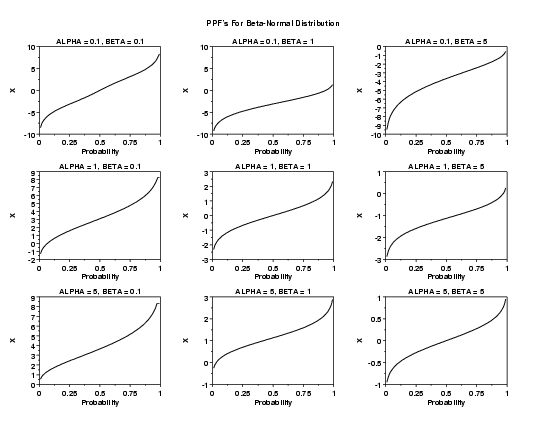

|
BNOPPFName:
 and and
 . .
![F(x;alpha,beta) = (1/BETA(ALPHA,BETA)*INTEGRAL[0 to G(x)]
[w**(alpha-1)*(1-w)**(beta-1)dw] alpha, beta > 0](eqns/bgxcdf.gif)
with G(x) denoting a function. That is, this is the beta cumulative distribution function, but the upper limit of integration is defined by another cumulative distribution function. The case where G(x) denotes the normal cumulative distribution function results in the beta-normal distribution with the following cumulative distribution function:
![F(x;alpha,beta) = (1/BETA(ALPHA,BETA)*INTEGRAL[0 to Phi(x)]
[w**(alpha-1)*(1-w)**(beta-1)dw] alpha, beta > 0](eqns/bnocdf.gif)
with The beta-normal percent point function is computed by numerically inverting the beta-normal cumulative distribution function.
This distribution can be extended with location and scale
parameters by replacing the standard normal distribution with a
normal distribution with location parameter,
<SUBSET/EXCEPT/FOR qualification> where <p> is a number, parameter, or variable in the range [0,1]; <y> is a variable or a parameter (depending on what <p> is) where the computed beta-normal ppf value is stored; <alpha> is a number, parameter, or variable that specifies the first shape parameter; <beta> is a number, parameter, or variable that specifies the second shape parameter; <loc> is a number, parameter, or variable that specifies the location parameter; <scale> is a number, parameter, or variable that specifies the scale parameter; and where the <SUBSET/EXCEPT/FOR qualification> is optional. The <loc> and <scale> parameters are optional.
LET X2 = BNOPPF(P1,0.1,0.1) PLOT BNOPPF(P,0.1,0.1) FOR P = 0.01 0.01 0.99
Eugene, Lee, and Famoye (2002). "Beta-Normal Distribution and Its Applications", Communications in Statistics-Theory and Methods, 31, pp. 497-512.
MULTIPLOT 3 3
MULTIPLOT CORNER COORDINATES 0 0 100 95
MULTIPLOT SCALE FACTOR 3
LABEL CASE ASIS
Y1LABEL X
X1LABEL Probability
X1LABEL DISPLACEMENT 14
Y1LABEL DISPLACEMENT 15
TITLE DISPLACEMENT 2
.
LET A = DATA 0.1 1 5
LET B = DATA 0.1 1 5
LOOP FOR K = 1 1 3
LET ALPHA = A(K)
LOOP FOR L = 1 1 3
LET BETA = B(L)
TITLE ALPHA = ^ALPHA, BETA = ^BETA
PLOT BNOPPF(P,ALPHA,BETA) FOR P = 0.01 0.01 0.99
END OF LOOP
END OF LOOP
.
END OF MULTIPLOT
JUSTIFICATION CENTER
MOVE 50 97
CASE ASIS
TEXT PPF's For Beta-Normal Distribution

Date created: 3/27/2006 |